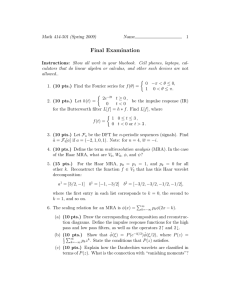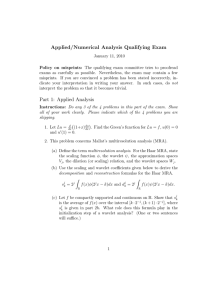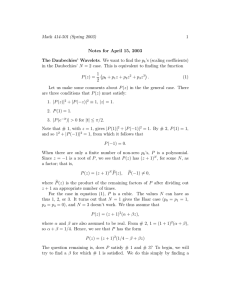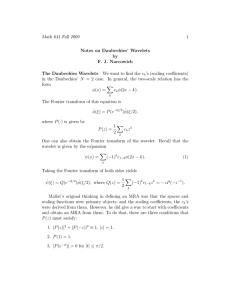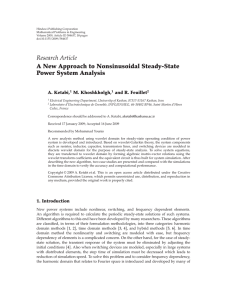Final Examination
advertisement
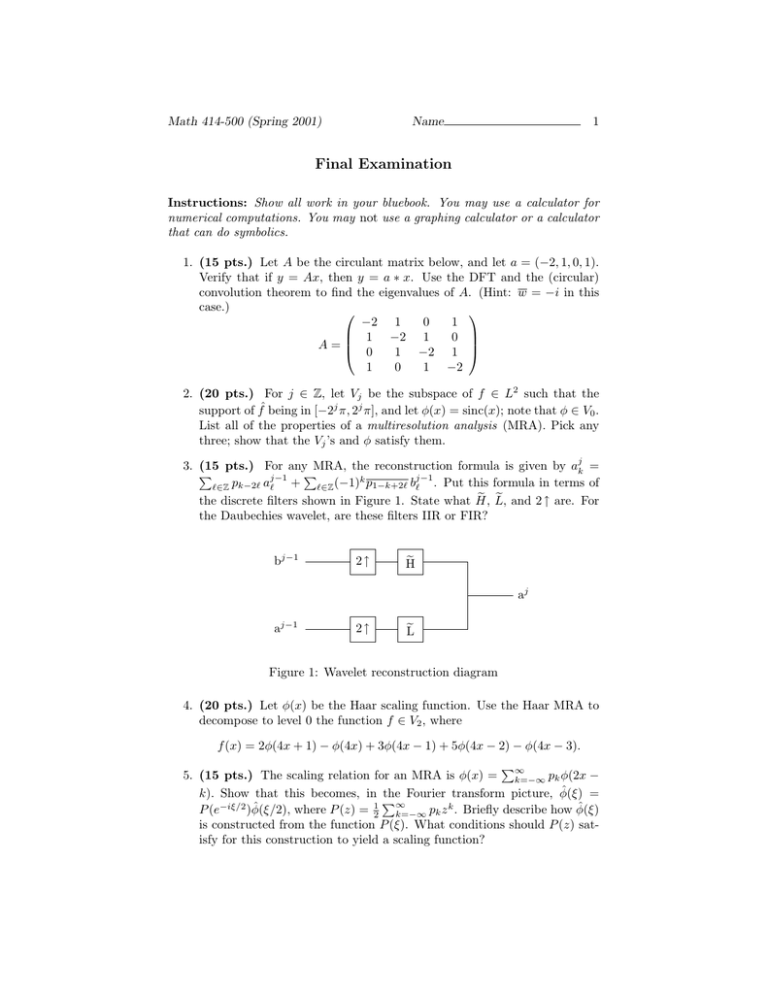
Math 414-500 (Spring 2001) Name 1 Final Examination Instructions: Show all work in your bluebook. You may use a calculator for numerical computations. You may not use a graphing calculator or a calculator that can do symbolics. 1. (15 pts.) Let A be the circulant matrix below, and let a = (−2, 1, 0, 1). Verify that if y = Ax, then y = a ∗ x. Use the DFT and the (circular) convolution theorem to find the eigenvalues of A. (Hint: w = −i in this case.) −2 1 0 1 1 −2 1 0 A= 0 1 −2 1 1 0 1 −2 2. (20 pts.) For j ∈ Z, let Vj be the subspace of f ∈ L2 such that the support of fˆ being in [−2j π, 2j π], and let φ(x) = sinc(x); note that φ ∈ V0 . List all of the properties of a multiresolution analysis (MRA). Pick any three; show that the Vj ’s and φ satisfy them. 3. (15 pts.) For any MRA, the reconstruction formula is given by ajk = P P j−1 + ℓ∈Z (−1)k p1−k+2ℓ bj−1 . Put this formula in terms of ℓ∈Z pk−2ℓ aℓ ℓ e L, e and 2 ↑ are. For the discrete filters shown in Figure 1. State what H, the Daubechies wavelet, are these filters IIR or FIR? bj−1 aj−1 2↑ 2↑ e H aj e L Figure 1: Wavelet reconstruction diagram 4. (20 pts.) Let φ(x) be the Haar scaling function. Use the Haar MRA to decompose to level 0 the function f ∈ V2 , where f (x) = 2φ(4x + 1) − φ(4x) + 3φ(4x − 1) + 5φ(4x − 2) − φ(4x − 3). P∞ 5. (15 pts.) The scaling relation for an MRA is φ(x) = k=−∞ pk φ(2x − k). Show that this becomes, in the Fourier transform picture, φ̂(ξ) = P∞ P (e−iξ/2 )φ̂(ξ/2), where P (z) = 12 k=−∞ pk z k . Briefly describe how φ̂(ξ) is constructed from the function P (ξ). What conditions should P (z) satisfy for this construction to yield a scaling function? 6. (15 pts.) For the Daubechies N = 2 MRA, the function P (z) is a polynomial, Ã √ ! √ 1+ 3 1− 3 2 + z . P (z) = (1 + z) 8 8 Use this and the formula ψ̂(ξ) = −e−iξ/2 P (−e−iξ/2 )φ̂(ξ/2) to show that the Daubechies wavelet has two vanishing moments. Briefly discuss the significance of this for singularity detection. Properties of the Fourier Transform 1 1. fˆ(ξ) = F[f ](ξ) = √ 2π Z ∞ f (x)e−ixξ dx. −∞ 1 2. f (x) = F −1 [fˆ](x) = √ 2π Z ∞ fˆ(ξ)eixξ dξ. −∞ 3. F[xn f (x)](ξ) = in fˆ(n) (ξ). 4. F[f (n) (x)](ξ) = (iξ)n fˆ(ξ). 5. F[f (x − a)](ξ) = e−iξa fˆ(ξ). 6. F[f (bx)](ξ) = 7. F[f ∗ g] = √ 1ˆξ f ( ). b b 2π fˆ(ξ)ĝ(ξ) sin(πx) = F −1 [χπ ], where χπ (ξ) = 8. sinc(x) := πx 2 ½ √ 1/ 2π, 0, −π ≤ ξ ≤ π . |ξ| > π
